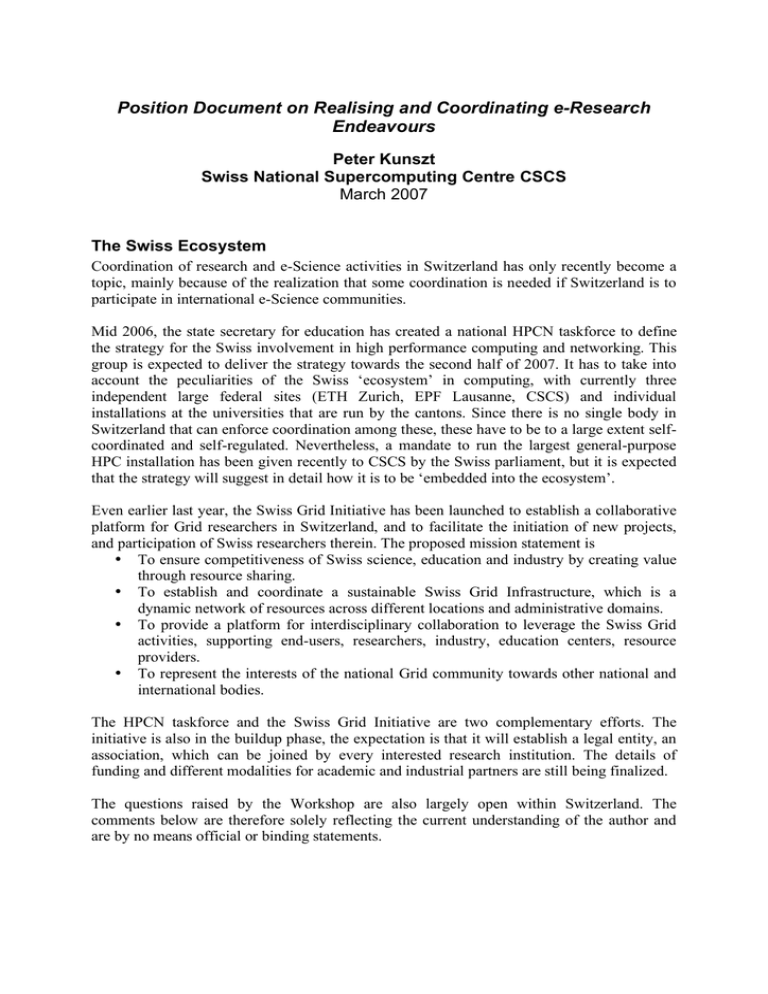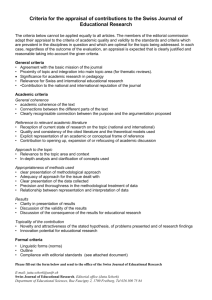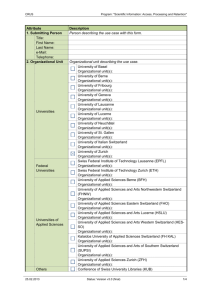Position Document on Realising and Coordinating e-Research Endeavours Peter Kunszt
advertisement

Position Document on Realising and Coordinating e-Research Endeavours Peter Kunszt Swiss National Supercomputing Centre CSCS March 2007 The Swiss Ecosystem Coordination of research and e-Science activities in Switzerland has only recently become a topic, mainly because of the realization that some coordination is needed if Switzerland is to participate in international e-Science communities. Mid 2006, the state secretary for education has created a national HPCN taskforce to define the strategy for the Swiss involvement in high performance computing and networking. This group is expected to deliver the strategy towards the second half of 2007. It has to take into account the peculiarities of the Swiss ‘ecosystem’ in computing, with currently three independent large federal sites (ETH Zurich, EPF Lausanne, CSCS) and individual installations at the universities that are run by the cantons. Since there is no single body in Switzerland that can enforce coordination among these, these have to be to a large extent selfcoordinated and self-regulated. Nevertheless, a mandate to run the largest general-purpose HPC installation has been given recently to CSCS by the Swiss parliament, but it is expected that the strategy will suggest in detail how it is to be ‘embedded into the ecosystem’. Even earlier last year, the Swiss Grid Initiative has been launched to establish a collaborative platform for Grid researchers in Switzerland, and to facilitate the initiation of new projects, and participation of Swiss researchers therein. The proposed mission statement is • To ensure competitiveness of Swiss science, education and industry by creating value through resource sharing. • To establish and coordinate a sustainable Swiss Grid Infrastructure, which is a dynamic network of resources across different locations and administrative domains. • To provide a platform for interdisciplinary collaboration to leverage the Swiss Grid activities, supporting end-users, researchers, industry, education centers, resource providers. • To represent the interests of the national Grid community towards other national and international bodies. The HPCN taskforce and the Swiss Grid Initiative are two complementary efforts. The initiative is also in the buildup phase, the expectation is that it will establish a legal entity, an association, which can be joined by every interested research institution. The details of funding and different modalities for academic and industrial partners are still being finalized. The questions raised by the Workshop are also largely open within Switzerland. The comments below are therefore solely reflecting the current understanding of the author and are by no means official or binding statements. Position Statements The encouragement for collaboration comes through funding, not only by the EU framework programmes but also through national initiatives. Interdisciplinary research is especially encouraged, from which computational sciences can profit directly. In terms of managing the collaborations, since they are bound to funded projects, this is defined by the founding agency. Ultimately, it is expected that the national infrastructure for HPCN and Grid will drive the efforts in this domain, and will be able to connect to the international projects with sufficient momentum. Although the mechanism for establishing e-Research projects has not been set down yet, the most probable mechanism will be to establish a body that allocates available resources such as ‘computing time’ through a scientific and technical peer-review process. At CSCS this is currently a two-stage process: there is a technical feasibility evaluation and then a scientific review, which will determine the resource allocation. Also a peer-review process is currently the practice for giving out funds in the Swiss National Foundation. The steering and matching of the scientific research with the latest technical achievements and technical capabilities of the Swiss infrastructure for HPCN and Grid has to come from the technical evaluation and feasibility studies explicitly, and the scientific peer review implicitly. Projects that are taking the technical developments into account, resulting in optimal use of the resources will be preferred automatically. Sustainability of the infrastructure has to be assured by direct funding of the infrastructure by the state and the cantons. The national HPCN and Grid infrastructures have to be coordinated somehow, although in Switzerland this coordination will be very loose and cannot be enforced due to the large autonomy of each center. The hope is that there will be dedicated funding for the national infrastructure in the future. Industrial partnerships still have to be developed, even the strategy how to enter these is currently missing. There are many models that can and should be exploited.




